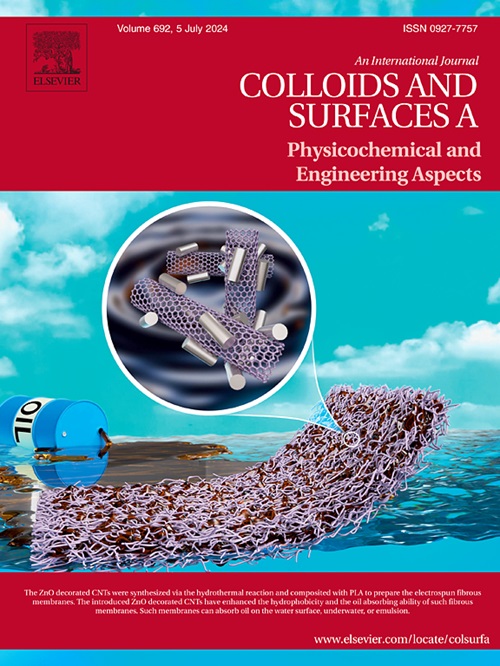Novel two-dimensional K-Ge₂C₄ monolayer as an anode for Li-/Na-ion batteries with high theoretical capacity
IF 5.4
2区 化学
Q2 CHEMISTRY, PHYSICAL
Colloids and Surfaces A: Physicochemical and Engineering Aspects
Pub Date : 2025-07-17
DOI:10.1016/j.colsurfa.2025.137767
引用次数: 0
Abstract
In this study, we utilized first-principles calculations to explore a two-dimensional (2D) multi-ring structure composed of carbon and germanium atoms and investigated its potential for Li/Na storage. This structure, consisting of 2 germanium atoms and 4 carbon atoms, is referred to as K-Ge₂C₄. Its stability, as well as mechanical, electronic, and energy storage-related properties, were also examined. he results show that the Young’s modulus and Poisson’s ratio confirm that K-Ge₂C₄ has a stable structure and good ductility. The high density of states near the Fermi level (0.831 state/eV/atom) indicates that the material exhibits superior conductivity. Furthermore, the density of states near the Fermi level increased to 1.473 and 2.001 state/eV/atom after Li and Na adsorption at the H₂ sites, suggesting high electronic transfer efficiency. The barriers to the diffusion potential for Li and Na are 0.223 and 0.121 eV, respectively, indicating excellent ionic diffusion capability in K-Ge₂C₄. Notably, the maximum storage capacity for Li and Na reaches as high as 975.49 mAhg−1, demonstrating an exceptionally high energy storage density. These findings highlight K-Ge₂C₄ as a highly promising 2D anode material for LIBs/NIBs, offering new insights into the development of 2D anode battery materials.
新型二维K-Ge₂C₄单层作为Li-/ na离子电池阳极,具有较高的理论容量
在这项研究中,我们利用第一性原理计算探索了由碳和锗原子组成的二维(2D)多环结构,并研究了其Li/Na存储的潜力。这种由2个锗原子和4个碳原子组成的结构被称为K-Ge₂C₄。它的稳定性,以及机械,电子和能量存储相关的性质,也进行了检查。杨氏模量和泊松比证实了K-Ge₂C₄具有稳定的结构和良好的延展性。费米能级附近的态密度(0.831个态/eV/原子)表明该材料具有优异的导电性。此外,在H₂位点吸附Li和Na后,费米能级附近的态密度分别增加到1.473和2.001个态/eV/原子,表明电子转移效率高。Li和Na的扩散势垒分别为0.223和0.121 eV,表明离子在K-Ge₂C₄中具有良好的扩散能力。值得注意的是,Li和Na的最大存储容量高达975.49 mAhg−1,显示出异常高的能量存储密度。这些发现突出了K-Ge₂C₄作为lib / nib极具前景的2D负极材料,为2D负极电池材料的发展提供了新的见解。
本文章由计算机程序翻译,如有差异,请以英文原文为准。
求助全文
约1分钟内获得全文
求助全文
来源期刊
CiteScore
8.70
自引率
9.60%
发文量
2421
审稿时长
56 days
期刊介绍:
Colloids and Surfaces A: Physicochemical and Engineering Aspects is an international journal devoted to the science underlying applications of colloids and interfacial phenomena.
The journal aims at publishing high quality research papers featuring new materials or new insights into the role of colloid and interface science in (for example) food, energy, minerals processing, pharmaceuticals or the environment.

 求助内容:
求助内容: 应助结果提醒方式:
应助结果提醒方式:


